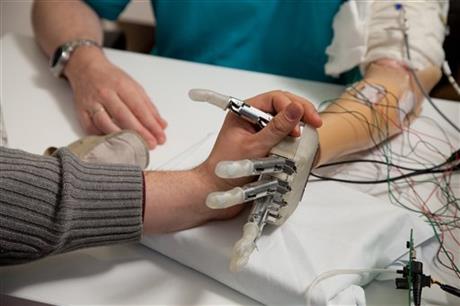WASHINGTON (AP) — It’s not quite the bionics of science fiction, but European researchers have created a robotic hand that gave an amputee a sense of touch he hadn’t felt in a decade.

The experiment lasted only a week, but it let the patient feel if different objects — a bottle, a baseball, some cotton, a mandarin orange — were hard or soft, slim or round, and intuitively adjust his grasp.
It will take years of additional research before an artificial hand that feels becomes a reality. But the research released Wednesday is part of a major effort to create more lifelike and usable prosthetics.
“It was just amazing,” said Dennis Aabo Sorensen of Aalborg, Denmark, who lost his left hand in a fireworks accident and volunteered to pilot-test the bulky prototype. “It was the closest I have had to feeling like a normal hand.”
This isn’t the first time scientists have tried to give some sense of touch to artificial hands; a few other pilot projects have been reported in the U.S. and Europe.
This newest experiment is among the most advanced, essentially creating a loop that let the robotic hand rapidly communicate with Sorensen’s brain so he could feel and react in real time. The work was published in the journal Science Translational Medicine.
“It was interesting to see how fast he was able to master this,” said neuroengineer Silvestro Micera of Switzerland’s Ecole Polytechnique Federale de Lausanne, who led the Swiss and Italian research team. “He was able to use this information immediately in a quite sophisticated way.”
Scientists have made great strides in recent years in improving the dexterity of prosthetics. But the sense of touch has been a much more difficult challenge and is one reason that many patients don’t use their prosthetic hands as much as they’d like.
Consider: Grab something and your own hand naturally grasps with just enough force to hang on. Users of prosthetic hands have to carefully watch every motion, judging by eye instead of touch how tightly to squeeze. The results can be clumsy, with dropped dishes or crushed objects.
“You always have to look and see what’s going on, so that’s what is so much different from this new hand that I tried,” Sorensen, 36, said in a telephone interview.
First, doctors at Rome’s Gemelli Hospital implanted tiny electrodes inside two nerves — the ulnar and median nerves — in the stump of Sorensen’s arm.
Those nerves normally would allow for certain sensations in a hand. When researchers zapped them with a weak electrical signal, Sorensen said it felt like his missing fingers were moving, showing the nerves still could relay information.
Meanwhile, Micera’s team put sensors on two fingers of a robotic hand to detect information about what the artificial fingers touched.
For one week, cords snaked from a bandage on Sorensen’s arm to the artificial hand, and the electrodes zapped the nerves in proportion to what the sensors detected.
“It is really putting the brain back in control of the system,” said biomedical engineer Dustin Tyler of Case Western Reserve University, who wasn’t involved with the European work but leads a team in Ohio that recently created and tested a similar touch-enabled hand. “That’s an important step.”
Added neurobiologist Andrew Schwartz of the University of Pittsburgh: “It shows with a few sensors and some pretty elementary technology, that they can recover a fair amount of functionality.”
To be sure Sorensen used touch, and didn’t cheat by looking or hearing telltale sounds, he wore a blindfold and headphones as Micera’s team handed him different objects.
“Suddenly I could tell if it was a hard object,” Sorensen recalled, describing sensations that changed along with his grip. “The response, the feedback from the arm to my nerves and to my brain, they came very strong.”
Micera cautioned that much more research is needed — starting with proof that these nerve implants can last. For safety reasons, Sorensen’s were surgically removed from his arm after the brief experiment.
But a lot of work is underway.
In Ohio, Tyler’s team recently issued video showing a blindfolded man gently pulling stems from cherries without crushing them, thanks to similar implanted nerve stimulators and a sensor-equipped prosthetic hand. The main difference, said Switzerland’s Micera, is in how the nerve electrodes are implanted. The European approach puts them inside the nerve rather than around it for better control, but that’s more invasive and some researchers worry it could damage the nerve over time.
In Pittsburgh, Schwartz’s team is about to test another approach — a brain-controlled robotic hand for the paralyzed that would “feel” through electrodes implanted in a brain region known as the sensory cortex.
Whatever the approach, touch is a complex sense and these are all basic first steps involving how someone grasps, not more sophisticated sensations such as texture or temperature.
“There is definitely tremendous value to having a sense of touch, a sense of feeling from the hand,” said Case Western’s Tyler. “What that feeling is, how we use it — that’s yet to come.”





